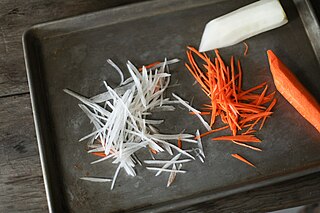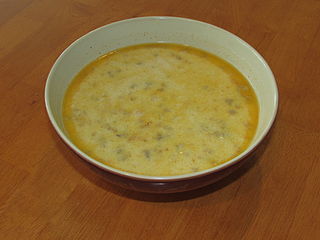
Apiaceae or Umbelliferae is a family of mostly aromatic flowering plants named after the type genus Apium and commonly known as the celery, carrot or parsley family, or simply as umbellifers. It is the 16th-largest family of flowering plants, with more than 3,700 species in 434 genera including such well-known and economically important plants as ajwain, angelica, anise, asafoetida, caraway, carrot, celery, chervil, coriander, cumin, dill, fennel, lovage, cow parsley, parsley, parsnip and sea holly, as well as silphium, a plant whose identity is unclear and which may be extinct.

Celery is a marshland plant in the family Apiaceae that has been cultivated as a vegetable since antiquity. Celery has a long fibrous stalk tapering into leaves. Depending on location and cultivar, either its stalks, leaves or hypocotyl are eaten and used in cooking. Celery seed powder is used as a spice.

A mirepoix is a flavor base made from diced vegetables cooked—usually with butter, oil, or other fat—for a long time on low heat without coloring or browning, as further cooking, often with the addition of tomato purée, creates a darkened brown mixture called pinçage. It is not sautéed or otherwise hard-cooked, because the intention is to sweeten the ingredients rather than caramelize them. It is a long-standing cooking technique in French cuisine.

The parsnip is a root vegetable closely related to carrot and parsley, all belonging to the flowering plant family Apiaceae. It is a biennial plant usually grown as an annual. Its long taproot has cream-colored skin and flesh, and, left in the ground to mature, it becomes sweeter in flavor after winter frosts. In its first growing season, the plant has a rosette of pinnate, mid-green leaves. If unharvested, in its second growing season it produces a flowering stem topped by an umbel of small yellow flowers, later producing pale brown, flat, winged seeds. By this time, the stem has become woody and the tap root inedible.

Arracacha is a root vegetable originally from the Andes, somewhat intermediate between the carrot and celery root. Its starchy taproot is a popular food item in South America where it is a major commercial crop.

Blanquette de veau is a French veal ragout in which neither the veal nor the butter is browned in the cooking process. To refrain from browning meat and fat in this way, is to cook them en blanquette.

Julienne, allumette, or french cut, is a culinary knife cut in which the food item is cut into long thin strips, similar to matchsticks. Common items to be julienned are carrots for carrots julienne, celery for céléris remoulade, potatoes for julienne fries, or cucumbers for naengmyeon.

The carrot fly is a pest of gardens and farms, and mainly affects the crop of carrots, but can also attack parsnips, parsley and celery. It is a member of the family Psilidae.

The carrot is a root vegetable, typically orange in color, though purple, black, red, white, and yellow cultivars exist, all of which are domesticated forms of the wild carrot, Daucus carota, native to Europe and Southwestern Asia. The plant probably originated in Persia and was originally cultivated for its leaves and seeds. The most commonly eaten part of the plant is the taproot, although the stems and leaves are also eaten. The domestic carrot has been selectively bred for its enlarged, more palatable, less woody-textured taproot.

Cercospora is a genus of ascomycete fungi. Most species have no known sexual stage, and when the sexual stage is identified, it is in the genus Mycosphaerella. Most species of this genus cause plant diseases, and form leaf spots. It is a relatively well-studied genus of fungus, but there are countless species not yet described, and there is still much to learn about the best-known of the species.

Olericulture is the science of vegetable growing, dealing with the culture of non-woody (herbaceous) plants for food.
Hodge-podge or hotch potch is a soup or stew, usually based on diced mutton or other meat, with green and root vegetables. It is familiar in different versions in Britain and North America and is particularly associated with Scotland.
Apium insulare, Flinders Island celery, or Island celery is a herb of the Bass Strait islands, and Lord Howe Island, Australia. It is a member of the Apiaceae (carrot family.
Apium virus Y (ApVY) is a plant pathogenic virus in the genus Potyvirus and the virus family Potyviridae.

Celery mosaic virus (CeMV) is a plant pathogenic virus in the genus Potyvirus and the virus family Potyviridae .

Zuppa toscana is a broad based term, literally meaning "Tuscan soup" but in Italy it is called "Minestra di Pane" meaning "Bread Soup". Classic zuppa toscana normally is a soup made from kale, zucchini, cannellini beans, potatoes, celery, carrots, onion, tomato pulp, extra virgin olive oil, salt, powdered chili, toasted Tuscan bread, and rigatino.

Torshi are the pickled vegetables of many Middle Eastern and Balkan cuisines.

Apio, also known as apiu is a Balkan Jewish appetizer made from celeriac and carrot and served cold. It is customary to serve the appetizer before the three-day holiday meal.















